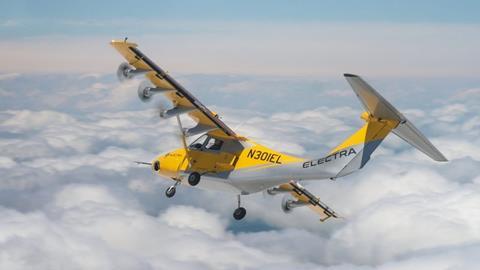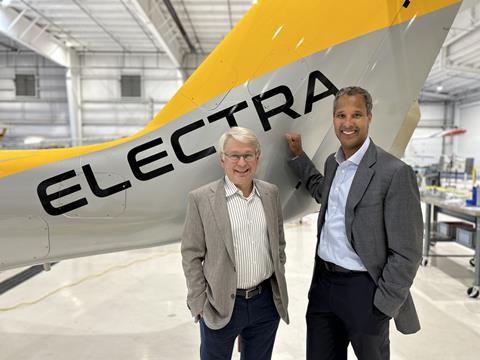Former Boeing executive Marc Allen thinks start-up Electra’s concept for a hybrid-electric, short take-off aircraft has far more commercial viability than other novel aircraft within the burgeoning advanced air mobility (AAM) space.
That is largely why Allen, who for several years led Boeing’s work of identifying promising aerospace technologies, agreed to join Electra as its new CEO.
“I’ve built up, over the last four years, a sense of what’s really going to work, to bring real change,” Allen tells FlightGlobal, saying Electra has a “realistic baseline”.
“The right technology is [a] distributed hybrid-electric propulsion system using the proprietary blown-lift aerodynamic design,” he adds. “All of that gives you this unique mission set.”

Allen became Electra CEO on 29 August, succeeding John Langford, who founded the Manassas, Virginia firm in 2020.
The AAM sector encompasses various breeds of small, in-development aircraft with novel propulsion systems intended to operate local or regional flights. It is awash with start-ups developing electric vertical take-off and landing (eVTOL) aircraft that use downward-facing props to generate vertical life. Such designs, however, face certification challenges and range limitations.
But Electra has taken a more-traditional approach. It is developing a nine-passenger aircraft with a fixed wing, which Allen says will allow for smoother certification under existing rules and for impressive range.
Notably, Electra says the concept will be able to take-off and land within roughly the same space as required for helicopters thanks to a “blown-lift” configuration. Specifically, it will have wing-mounted props (the concept has eight on each wing) that will direct air over the wings in a manner generating additional lift.
As a result, the aircraft will require only 91m (300ft) of take-off space, meaning it could operate from an envisioned network of convenient-to-access facilities, even from converted parking lots, the company says.
Electra puts the concept’s flight speed at 174kt (322km/h), its range at 435nm (805km) and its payload at 1,134kg (2,500lb). The company aims to have the design certificated in 2028.

Allen says the aircraft will fly farther than eVTOLs, be quieter and cheaper than helicopters, and be more practical and accessible than traditional general aviation aircraft.
While its “blown-lift” design is fairly unique, Electra is among several players predicting that future regional aircraft will be fixed-wing types with hybrid-electric power. Other developers of such concepts include Embraer and start-ups Ascendance and Heart Aerospace.
Allen joins Electra after having been Boeing’s chief strategy officer and vice-president of strategy and corporate development from October 2020 to end-2023. In that role, he oversaw Boeing venture efforts, including its May 2023 acquisition of California-based air taxi developer Wisk Aero.
Earlier, Allen was president of Boeing International, president of Boeing Capital, president of Boeing’s China business and vice-president of its global law division.
Aerospace entrepreneur Langford founded Electra in 2020 and had previously founded Aurora Flight Sciences, which Boeing bought in 2017. Langford now retains his role as Electra’s board chair and will continue guiding its strategy, the company says.
Veterans of Airbus, Aurora, Boeing, Honda Aircraft and Pratt & Whitney compose Electra’s executive team. Chief product officer Marc Ausman formerly led Airbus’s air taxi project, and chief engineer Oliver Masefield had been a chief engineer at Pilatus Aircraft.
Electra in November 2023 completed first flight of its EL-2 Goldfinch, a demonstrator it is using to evaluate the blown-lift design. In May it completed the first demonstration of EL-2’s short take-off and landing capability, and on 29 August completed the aircraft’s 50th flight, all from Manassas Regional airport.
Allen declines to discuss Electra’s financials but notes the company has received funding from the US Department of Defense, which sees military potential. Lockheed Martin and venture-capital fund Statkraft Ventures have also invested.
Electra has received letters of intent from 52 customers covering potential orders for 2,000 aircraft and has signed up with some suppliers. Honeywell has agreed to provide flight-control computers and electromechanical actuation systems, while Safran Helicopter Engines is to supply turbo-generators.
Electra and other AAM developers face a long and expensive process to certification, while raising fresh capital to fund that process has became more difficult in recent years amid higher interest rates. One notable start-up, Universal Hydrogen, exhausted its cash, folding this year.
But Allen thinks it is becoming increasingly clear which projects are viable and which are not.
“I think investors have recognised that there are a number of proposed product solutions – platform approaches – that aren’t likely to work in the marketplace,” he says, while declining to be specific.
Now, he foresees investment dollars coalescing around the strongest ideas.
“There’s still a very meaningful appetite for [investment in] those who have the product solutions that work,” he says. “There’s meaningful interest in finding the right mousetrap.”


























